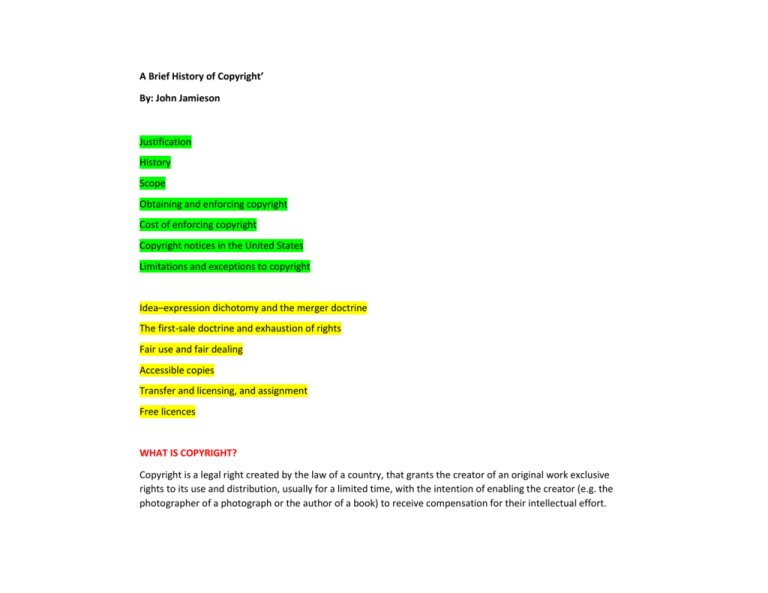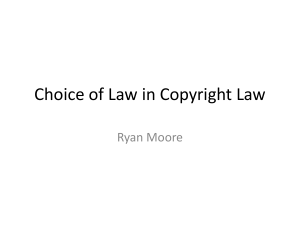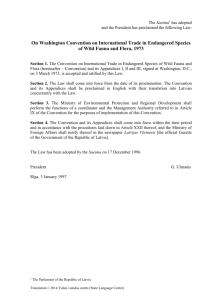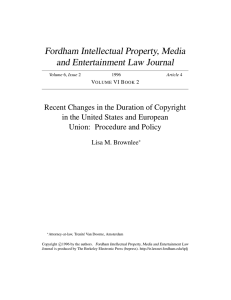
A Brief History of Copyright’
By: John Jamieson
Justification
History
Scope
Obtaining and enforcing copyright
Cost of enforcing copyright
Copyright notices in the United States
Limitations and exceptions to copyright
Idea–expression dichotomy and the merger doctrine
The first-sale doctrine and exhaustion of rights
Fair use and fair dealing
Accessible copies
Transfer and licensing, and assignment
Free licences
WHAT IS COPYRIGHT?
Copyright is a legal right created by the law of a country, that grants the creator of an original work exclusive
rights to its use and distribution, usually for a limited time, with the intention of enabling the creator (e.g. the
photographer of a photograph or the author of a book) to receive compensation for their intellectual effort.
Copyright is a form of intellectual property (as patents, trademarks and trade secrets are), applicable to any
expressible form of an idea or information.[1] It is often shared, then percentage holders are commonly called
rights holders: legally, contractually and in associated "rights" business functions.[citation needed] Generally
rights holders have "the right to copy", but also the right to be credited for the work, to determine who may
adapt the work to other forms, who may perform the work, who may financially benefit from it, and other
related rights.
As far back as 1787, the United States Constitution provided for the protection of copyrights "to promote the
Progress of Science and useful Arts."[2] The contemporary intent of copyright is to promote the creation of new
works by giving authors control of and profit from them. Copyrights are said to be territorial, which means that
they do not extend beyond the territory of a specific state unless that state is a party to an international
agreement. Today, however, this is less relevant since most countries are parties to at least one such
agreement. While many aspects of national copyright laws have been standardized through international
copyright agreements, copyright laws of most countries have some unique features.[3] Typically, the duration of
copyright is the whole life of the creator plus fifty to a hundred years from the creator's death, or a finite period
for anonymous or corporate creations. Some jurisdictions have required formalities to establishing copyright,
but most recognize copyright in any completed work, without formal registration. Generally, copyright is
enforced as a civil matter, though some jurisdictions do apply criminal sanctions.
Most jurisdictions recognize copyright limitations, allowing "fair" exceptions to the creator's exclusivity of
copyright, and giving users certain rights. The development of digital media and computer network technologies
have prompted reinterpretation of these exceptions, introduced new difficulties in enforcing copyright, and
inspired additional challenges to copyright law's philosophic basis. Simultaneously, businesses with great
economic dependence upon copyright, such as those in the music business, have advocated the extension and
expansion of their intellectual property rights, and sought additional legal and technological enforcement.
Copyright came about with the invention of the printing press and with wider public literacy. As a legal concept,
its origins in Britain were from a reaction to printers' monopolies at the beginning of the 18th century. Charles II
of England was concerned by the unregulated copying of books and passed the Licensing of the Press Act 1662
by Act of Parliament,[5] which established a register of licensed books and required a copy to be deposited with
the Stationers' Company, essentially continuing the licensing of material that had long been in effect.
THE STATUTE OF ANNE
The British Statute of Anne (1710) further alluded to individual rights of the artist. It began, "Whereas Printers,
Booksellers, and other Persons, have of late frequently taken the Liberty of Printing... Books, and other Writings,
without the Consent of the Authors... to their very great Detriment, and too often to the Ruin of them and their
Families:".[6] A right to benefit financially from the work is articulated, and court rulings and legislation have
recognized a right to control the work, such as ensuring that the integrity of it is preserved. An irrevocable right
to be recognized as the work's creator appears in some countries' copyright laws.
Copyright laws allow products of creative human activities, such as literary and artistic production, to be
preferentially exploited and thus incentivized. Different cultural attitudes, social organizations, economic models
and legal frameworks are seen to account for why copyright emerged in Europe and not, for example, in Asia. In
the Middle Ages in Europe, there was generally a lack of any concept of literary property due to the general
relations of production, the specific organization of literary production and the role of culture in society. The
latter refers to the tendency of oral societies, such as that of Europe in the medieval period, to view knowledge
as the product and expression of the collective, rather than to see it as individual property. However, with
copyright laws, intellectual production comes to be seen as a product of an individual, with attendant rights. The
most significant point is that patent and copyright laws support the expansion of the range of creative human
activities that can be commodified. This parallels the ways in which capitalism led to the commodification of
many aspects of social life that earlier had no monetary or economic value per se.[7]
The Statute of Anne was the first real copyright act, and gave the publishers rights for a fixed period, after which
the copyright expired.[8] Copyright has grown from a legal concept regulating copying rights in the publishing of
books and maps to one with a significant effect on nearly every modern industry, covering such items as sound
recordings, films, photographs, software, and architectural works.
Prior to the passage of the United States Constitution, several states passed their own copyright laws between
1783 and 1787, the first being Connecticut.[9] Contemporary scholars and patriots such as Noah Webster, John
Trumbull (poet), and Joel Barlow were instrumental in securing the passage of these statutes.[9]
THE COPYRIGHT ACT OF 1790
The Copyright Clause of the United States Constitution (1787) authorized copyright legislation: "To promote the
Progress of Science and useful Arts, by securing for limited Times to Authors and Inventors the exclusive Right to
their respective Writings and Discoveries." That is, by guaranteeing them a period of time in which they alone
could profit from their works, they would be enabled and encouraged to invest the time required to create
them, and this would be good for society as a whole. A right to profit from the work has been the philosophical
underpinning for much legislation extending the duration of copyright, to the life of the creator and beyond, to
their heirs.
The original length of copyright in the United States was 14 years, and it had to be explicitly applied for. If the
author wished, they could apply for a second 14‑year monopoly grant, but after that the work entered the
public domain, so it could be used and built upon by others.
The Pirate Publisher—An International Burlesque that has the Longest Run on Record, from Puck, 1886, satirizes
the then-existing situation where a publisher could profit by simply stealing newly published works from one
country, and publishing them in another, and vice-versa.
The 1886 Berne Convention first established recognition of copyrights among sovereign nations, rather than
merely bilaterally. Under the Berne Convention, copyrights for creative works do not have to be asserted or
declared, as they are automatically in force at creation: an author need not "register" or "apply for" a copyright
in countries adhering to the Berne Convention.[11] As soon as a work is "fixed", that is, written or recorded on
some physical medium, its author is automatically entitled to all copyrights in the work, and to any derivative
works unless and until the author explicitly disclaims them, or until the copyright expires. The Berne Convention
also resulted in foreign authors being treated equivalently to domestic authors, in any country signed onto the
Convention. The UK signed the Berne Convention in 1887 but did not implement large parts of it until 100 years
later with the passage of the Copyright, Designs and Patents Act of 1988. The United States did not sign the
Berne Convention until 1989.[12]
The United States and most Latin American countries instead entered into the Buenos Aires Convention in 1910,
which required a copyright notice on the work (such as all rights reserved), and permitted signatory nations to
limit the duration of copyrights to shorter and renewable terms.[13][14][15] The Universal Copyright Convention
was drafted in 1952 as another less demanding alternative to the Berne Convention, and ratified by nations such
as the Soviet Union and developing nations.
The regulations of the Berne Convention are incorporated into the World Trade Organization's TRIPS agreement
(1995), thus giving the Berne Convention effectively near-global application.[16] The 2002 WIPO Copyright
Treaty enacted greater restrictions on the use of technology to copy works in the nations that ratified it.
SCOPE
Copyright may apply to a wide range of creative, intellectual, or artistic forms, or "works". Specifics vary by
jurisdiction, but these can include poems, theses, plays and other literary works, motion pictures, choreography,
musical compositions, sound recordings, paintings, drawings, sculptures, photographs, computer software, radio
and television broadcasts, and industrial designs. Graphic designs and industrial designs may have separate or
overlapping laws applied to them in some jurisdictions.[17][18]
Copyright does not cover ideas and information themselves, only the form or manner in which they are
expressed.[19] For example, the copyright to a Mickey Mouse cartoon restricts others from making copies of the
cartoon or creating derivative works based on Disney's particular anthropomorphic mouse, but does not
prohibit the creation of other works about anthropomorphic mice in general, so long as they are different
enough to not be judged copies of Disney's.[19] Note additionally that Mickey Mouse is not copyrighted because
characters cannot be copyrighted; rather, Steamboat Willie is copyrighted and Mickey Mouse, as a character in
that copyrighted work, is afforded protection.
In many jurisdictions, copyright law makes exceptions to these restrictions when the work is copied for the
purpose of commentary or other related uses (See fair use, fair dealing). It should be noted that US copyright
does NOT cover names, title, short phrases or Listings (such as ingredients, recipes, labels, or formulas).[20]
However there are protections available for those areas copyright does not cover – such as trademarks and
patents.
Copyright laws are standardized somewhat through international conventions such as the Berne Convention and
Universal Copyright Convention. These multilateral treaties have been ratified by nearly all countries, and
international organizations such as the European Union or World Trade Organization require their member
states to comply with them.
OBTAINING AND ENFORCING COPYRIGHT
A copyright certificate for proof of the Fermat theorem, issued by the State Department of Intellectual Property
of Ukraine.
Typically, a work must meet minimal standards of originality in order to qualify for copyright, and the copyright
expires after a set period of time (some jurisdictions may allow this to be extended). Different countries impose
different tests, although generally the requirements are low; in the United Kingdom there has to be some 'skill,
labour, and judgment' that has gone into it.[21] In Australia and the United Kingdom it has been held that a
single word is insufficient to comprise a copyright work. However, single words or a short string of words can
sometimes be registered as a trademark instead.
Copyright law recognizes the right of an author based on whether the work actually is an original creation,
rather than based on whether it is unique; two authors may own copyright on two substantially identical works,
if it is determined that the duplication was coincidental, and neither was copied from the other.
In all countries where the Berne Convention standards apply, copyright is automatic, and need not be obtained
through official registration with any government office. Once an idea has been reduced to tangible form, for
example by securing it in a fixed medium (such as a drawing, sheet music, photograph, a videotape, or a
computer file), the copyright holder is entitled to enforce his or her exclusive rights.[11] However, while
registration isn't needed to exercise copyright, in jurisdictions where the laws provide for registration, it serves
as prima facie evidence of a valid copyright and enables the copyright holder to seek statutory damages and
attorney's fees. (In the USA, registering after an infringement only enables one to receive actual damages and
lost profits.)
The original holder of the copyright may be the employer of the author rather than the author himself, if the
work is a "work for hire".[22] For example, in English law the Copyright, Designs and Patents Act 1988 provides
that if a copyrighted work is made by an employee in the course of that employment, the copyright is
automatically owned by the employer which would be a "Work for Hire."
Copyrights are generally enforced by the holder in a civil law court, but there are also criminal infringement
statutes in some jurisdictions. While central registries are kept in some countries which aid in proving claims of
ownership, registering does not necessarily prove ownership, nor does the fact of copying (even without
permission) necessarily prove that copyright was infringed. Criminal sanctions are generally aimed at serious
counterfeiting activity, but are now becoming more commonplace as copyright collectives such as the RIAA are
increasingly targeting the file sharing home Internet user. Thus far, however, most such cases against file sharers
have been settled out of court. (See: Legal aspects of file sharing)
COST OF ENFORCING COPYRIGHT
In most jurisdictions the copyright holder must bear the cost of enforcing copyright. This will usually involve
engaging legal representation, administrative and or court costs. These costs, including time, should be taken
into consideration when evaluating the benefits of enforcing copyright. In light of this, many copyright disputes
are settled by a direct approach to the infringing party in order to settle the dispute out of court.
COPYRIGHT NOTICES IN THE UNITED STATES
Before 1989, the use of a copyright notice – consisting of the copyright symbol (©, the letter C inside a circle),
the abbreviation "Copr.", or the word "Copyright", followed by the year of the first publication of the work and
the name of the copyright holder – was part of U. S. statutory requirements.[23][24] Several years may be noted
if the work has gone through substantial revisions. The proper copyright notice for sound recordings of musical
or other audio works is a sound recording copyright symbol (℗, the letter P inside a circle), which indicates a
sound recording copyright, with the letter P indicating a "phonorecord". Similarly, the phrase All rights reserved
was once required to assert copyright.
In 1989 the United States enacted the Berne Convention Implementation Act, amending the 1976 Copyright Act
to conform to most of the provisions of the Berne Convention. As a result, the use of copyright notices has
become optional to claim copyright, because the Berne Convention makes copyright automatic.[25] However,
the lack of notice of copyright using these marks may have consequences in terms of reduced damages in an
infringement lawsuit – using notices of this form may reduce the likelihood of a defense of "innocent
infringement" being successful.[26]








